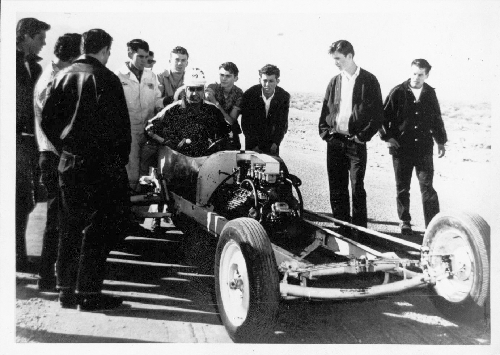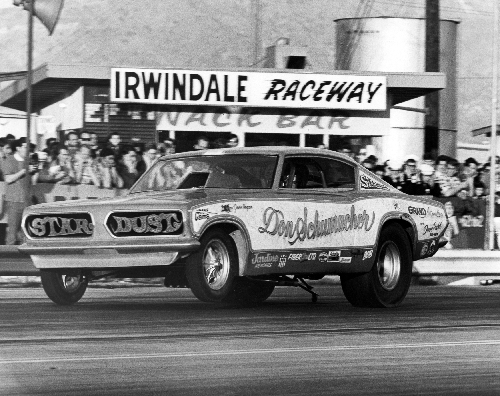Drag racing roots run deep in Southern Nevada
The quest for ultimate speed on a straight-line course can be traced to the 1930s on dry lake beds in California's Mojave Desert.
The popularity of those acceleration contests boomed after World War II, when veterans returned possibly with more derring-do, combined with a burgeoning American auto industry, to provide a perfect storm for the birth of wild combinations of engines, bodies and frames to make building hot rods a high-speed cult.
Wally Parks realized in 1950 that building and racing hot rods wasn't just a fad.
Parks began working to find safe, controlled environments in which Southern California rodders could challenge the limits of their mechanical creativity and push the limits of their machines. His effort led to the creation of the National Hot Rod Association 60 years ago.
Shortly thereafter, the new sport of drag racing sped to Southern Nevada.
Cruising down Main Street in a hot rod was the cool thing to do before drag racing came along.
In 1953, a patch of pavement on Vegas Valley Drive was devoted to organized, part-time drag races. It was the first of Southern Nevada's eight dragstrips.
"We lived 'American Graffiti,' " Steve Kirby, an original member of the Las Vegas Hustlers car club, told the Review-Journal in 2001. A noted body fabricator, Kirby, 69, died earlier this month.
Other original Las Vegas drag racers now in their 70s credit local car clubs Hustlers, Sinners and Crapshooters for fueling racing fever in the mid-1950s.
No official date can be pegged for the first drag race in Southern Nevada, but drag racing has been nearly nonstop -- though occasionally sporadic -- since those first organized races on Vegas Valley Drive. But it wasn't until nearly five decades later that the world's premier drag racing series came to Las Vegas.
This weekend's SummitRacing.com NHRA Nationals marks the 12th year the NHRA pro tour will visit Las Vegas Motor Speedway.
Parks initially laid out the dragstrip when the speedway complex was being built in the mid-1990s. The dragstrip and its 20,000-seat stadium were not completed until 2000, a year after the speedway was purchased by Speedway Motorsports Inc. Parks, who died in 2007 at the age of 94, lived to see his dream come true.
Race cars this weekend will use space-age material, computers and the latest electronic gizmos available from what has become a billion dollar high-performance industry.
Through the 1950s and 1960s, the most popular speed shops were junkyards, and none were more accommodating than Burt and Cecilia Gibbs' shop on North A Street.
"We grew up in the junkyard," said Cecil Fredi, an original Hustler. "We had the love to race without a budget. So we hung out at the junkyard (to find our parts)."
The Gibbs' son, Fred Gibbs, was always there to help with parts. The younger Gibbs also was a hot-rodder and raced his highly modified 1931 Ford Bantam-bodied roadster until he died in a 1961 car accident while returning from the U.S. Fuel and Gas Championships in Bakersfield, Calif.
"Fred was our catalyst, our mentor," said Fredi, who helped work on and drove Gibbs' Bantam.
Drag racing pioneers had to use the blood-and-sweat spirit of innovation, devising ways to breed speed. Front-end suspensions from 1939 Fords and rear ends from 1940 Fords were attached to Model A chassis to make many of the earliest dragsters.
Ford Flatheads and Oldsmobile engines were the hot power plants. Then came 354 Chrysler Hemis and soon Chevrolet V-8s.
Add a transmission from a LaSalle, and weld together some scrap tubing if you wanted a rollbar.
Regardless of how parts were combined to make a hot rod, it couldn't transition to a race car until there was a safe, legal place to race.
With the Vegas Valley Drive venue, local rodders had a place to race -- legally. Until then, club gatherings in downtown Las Vegas led to car cruises, and occasional challenges often turned into informal and illegal street races on the outskirts of town, when it was only a few blocks from Main Street.
Original club members recall Sheriff Butch Leypoldt assigning officers to oversee the Vegas Valley Drive races. One of their favorites, Las Vegas police officer Dale "Gunsmoke" Swift, kept a watchful eye on them
"No one wanted us to race (illegally) on the streets, and the police began to accommodate us," Fredi said.
That first dragstrip lasted through 1954. Side-by-side races were started by a flagman, with volunteers putting on races using timing equipment borrowed from the Las Vegas Sports Car Club. Jack "Ace" Hanley began organizing weekend events there and started the Las Vegas Drag Racing Association.
In 1956, the newly proclaimed drag racers shifted to Vegas Drive and conducted races on the site near what is now the Las Vegas Municipal Golf Course.
Local speed merchants spent 1957 competing on another quarter-mile of pavement on Highland Drive, near what is now Sahara Avenue.
It wasn't until 1958, when the city of Henderson provided a patch of asphalt near what was Dick Stewart Motors, that the first true dragstrip was built in Southern Nevada. It was called Thunderbird Raceway and now is the site of a new car dealership on Boulder Highway near Water Street. The Henderson track survived until 1964.
After it closed, racers went two years without an approved venue, often reverting to illegal races around town. Then the Stardust Raceway was built at Tropicana Avenue and Rainbow Boulevard. Legendary racer "Big Daddy" Don Garlits was one of many top national racers who competed on the track, believed to have been built by owners of the Stardust Hotel and Casino.
One word comes to mind when Don Schumacher recalls the area's first major dragstrip: sand.
"When I raced my Funny Car at Stardust Raceway, all I remember was how much sand was on the track," said Schumacher, a Chicago native and one of the first to join the Funny Car craze that began in the mid-1960s. Schumacher will field six pro cars in this weekend's event at LVMS.
Schumacher has much fondness for Stardust, but it's less for the racing surface and more for the casino that sponsored his Funny Car for several years.
The Stardust track went dark in 1971, when Pardee-Phillips bought the property for a housing development.
The area went without a dragstrip for eight years, but races -- some legal, some not -- were held on the outskirts of Las Vegas. The Southern Nevada Timing Association was formed and staged races south of town on old Highway 91, near Jean and Sloan.
"We called it Jean International,'" said Ken Black, who raced there.
Black, 65, whose Pro Stock teams have won five of the last eight NHRA season championships, started to race in the mid-1960s and was a regular when Speedrome opened on Las Vegas Boulevard North across from Nellis Air Force Base, on what is now Las Vegas Motor Speedway property.
"We called that the Sand-drome," Black laughed.
Nearly every major drag racer from Garlits to Shirley Muldowney competed at the Speedrome during its 21 years before being replaced by the state-of-the-art quarter-mile at the speedway, where the biggest names in drag racing will race this weekend.
Contact reporter Jeff Wolf at jwolf@reviewjournal.com or 702-383-0247.


















